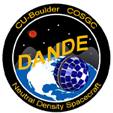 The DANDE team is having issues locating the satellite since 10/1/2013 at 14:00 UTC. Please click here and pick an object to help us out. (Start with object 2013-055B) All help is greatly appreciated!
The DANDE team is having issues locating the satellite since 10/1/2013 at 14:00 UTC. Please click here and pick an object to help us out. (Start with object 2013-055B) All help is greatly appreciated!
Source: DANDE Radio operators information.

 The DANDE team is having issues locating the satellite since 10/1/2013 at 14:00 UTC. Please click here and pick an object to help us out. (Start with object 2013-055B) All help is greatly appreciated!
The DANDE team is having issues locating the satellite since 10/1/2013 at 14:00 UTC. Please click here and pick an object to help us out. (Start with object 2013-055B) All help is greatly appreciated!
Source: DANDE Radio operators information.
After being confronted with a large number of objects via celestrak.com I saw T.S. Kelso his tweet on twitter where he is also trying to find out why there are so many object after the Falcon 9 v1.1 launch. “Trying to make sense of today’s Falcon 9 launch. There were supposed to be 6 payloads, but we have 20 objects (so far). TLEs are online.” Via Spacenews I found the following possible explanation for this.
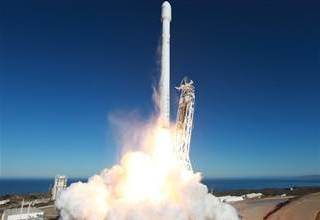 U.S. Space Surveillance Network is tracking a large number of objects after Falcon 9 v1.1 Launch.
U.S. Space Surveillance Network is tracking a large number of objects after Falcon 9 v1.1 Launch.
SpaceX issued a statement Oct. 1 denying speculation that the upper stage of its Falcon 9 v1.1. rocket exploded on orbit following the rocket’s successful demonstration launch Sept. 29 from the Vandenberg Air Force Base in California.
The speculation was spawned in part by the fact that the U.S. Space Surveillance Network is currently tracking more orbital objects associated with the launch than expected.
“Regarding the rumors you may have heard about the Falcon 9 second stage, in short, our data confirms there was no rupture of any kind on the second stage,” SpaceX spokeswoman Emily Shanklin wrote in an Oct. 1 email. “Following separation of the satellites to their correct orbit, the Falcon 9 second stage underwent a controlled venting of propellants … and the stage was successfully safed. During this process, it is possible insulation came off the fuel dome on the second stage and is the source of what some observers incorrectly interpreted as a rupture in the second stage.”
SpaceX attempted to reignite the upper stage after payload separation in a demonstration of a capability it will need to place satellites into the proper geostationary transfer orbit. However, the re-ignition sequence was aborted after a problem was detected, SpaceX Chief Executive Elon Musk told reporters in a post-launch teleconference.
 Following the launch, an eyewitness in Reunion Island off the eastern coast of Madagascar posted a photograph on the website Reddit of what amateur astronomers later determined was a cloud of rocket propellent surrounding the spent Falcon 9 1.1 upper stage. By Sept. 30, the U.S Air Force-run Space Surveillance System was tracking 20 objects associated with the launch in low Earth orbit. Experts were expecting to see 11 objects, including Cassiope; the three secondary payloads, one of which released seven independently flying objects; and the upper stage.
Following the launch, an eyewitness in Reunion Island off the eastern coast of Madagascar posted a photograph on the website Reddit of what amateur astronomers later determined was a cloud of rocket propellent surrounding the spent Falcon 9 1.1 upper stage. By Sept. 30, the U.S Air Force-run Space Surveillance System was tracking 20 objects associated with the launch in low Earth orbit. Experts were expecting to see 11 objects, including Cassiope; the three secondary payloads, one of which released seven independently flying objects; and the upper stage.
SpaceX’s explanation of events is copied below:
Following separation of the satellites to their correct orbit, the Falcon 9 second stage underwent a controlled venting of propellants (fuel and pressure were released from the tank) and the stage was successfully safed. During this process, it is possible insulation came off the fuel dome on the second stage and is the source of what some observers incorrectly interpreted as a rupture in the second stage. This material would be in several pieces and be reflective in the Space Track radar. It is also possible the debris came from the student satellite separation mechanisms onboard. SpaceX will continue to review to help identify the source of the extra debris, but our data confirms there was no rupture of any kind on the second stage.
Source: Spacenews
CubeBUG-1 01-10-2013 09:55 UTC Active
The small satellite CubeBUG-1 was active during this pass. I am still unable to decode the data because I am not able to receive a high enough signal. The transmissions are in a clear pattern as you can see in the below SDR spectrum.
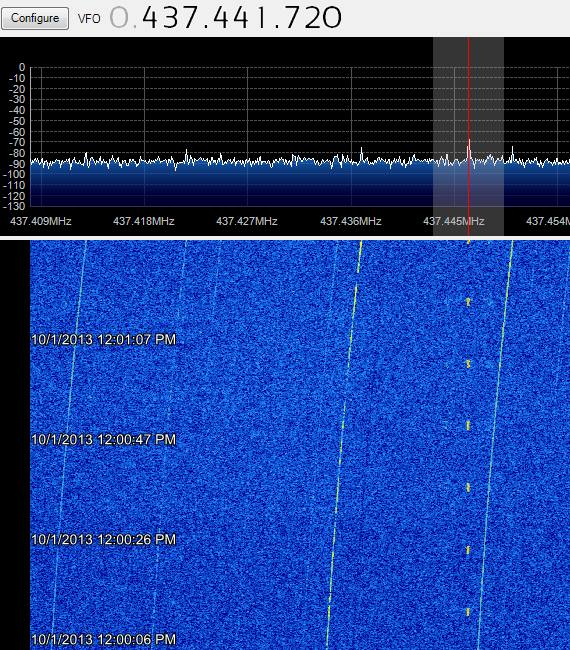
DANDE Telemetry 30-09-2013 09:12 – 09: 15 UTC.
This morning my first try to decode the telemetry data from the new satellite DANDE. I could decode in total 12 frames during this short pass.

[136 Bytes KISS Frame (without CRC)] 1 > C0 00 88 82 9C 88 8A 40 62 88 82 9C 88 8A 40 65 03 3A 64 61 21 > 6E 64 65 63 6F 73 67 63 00 00 EC 98 00 01 00 00 00 00 00 00 41 > 00 00 05 F7 00 04 00 00 D0 02 00 00 00 00 00 FF 02 01 82 01 61 > 08 00 00 01 9F 00 58 00 FC 00 F5 00 EC 01 17 01 0A 28 00 00 81 > 01 0F F3 00 24 0D 7E 0B F0 0E E2 06 CF 06 1F 06 1F 05 EF 00 101 > 01 05 C8 09 B1 3B 9A 3B 9A 0E 3A 00 00 00 00 64 61 6E 64 65 121 > 2E 63 6F 6C 6F 72 61 64 6F 2E 65 64 75 48 E6 C0 À.ˆ‚œˆŠ@bˆ‚œˆŠ@e.:dandecosgc..ì˜...........÷....Ð......ÿ..‚.....Ÿ.X. ü.õ.ì....(....ó.$.~.ð.â.Ï.....ï...È.±;š;š.:....dande.colorado.eduHæÀ [30 Bytes TIME Frame] 1 > C0 09 32 30 31 33 2D 30 39 2D 33 30 20 30 39 3A 31 31 3A 35 21 > 36 2E 37 34 30 20 55 54 43 C0 À.2013-09-30 09:11:56.740 UTCÀ [136 Bytes KISS Frame (without CRC)] 1 > C0 00 88 82 9C 88 8A 40 62 88 82 9C 88 8A 40 65 03 3A 64 61 21 > 6E 64 65 63 6F 73 67 63 00 00 EC CB 00 01 00 00 00 00 00 00 41 > 00 00 05 F7 00 04 00 00 D0 02 00 00 00 00 00 FF 02 01 81 01 61 > 08 00 00 01 AB 00 58 00 FC 00 F5 00 EC 01 17 01 0A 28 00 00 81 > 01 0F F3 00 24 0D 7E 0B F0 0E E2 06 D5 06 1E 06 1D 05 EF 00 101 > 01 05 C8 09 B1 3B 9A 3B 9A 0E 3A 00 00 00 00 64 61 6E 64 65 121 > 2E 63 6F 6C 6F 72 61 64 6F 2E 65 64 75 34 CA C0 À.ˆ‚œˆŠ@bˆ‚œˆŠ@e.:dandecosgc..ìË...........÷....Ð......ÿ.......«.X.\ ü.õ.ì....(....ó.$.~.ð.â.Õ.....ï...È.±;š;š.:....dande.colorado.edu4ÊÀ
Received data can be downloaded at the following location: DANDE Download location
DANDE was launched with the Falcon 9 from SpaceX’s pad at Vandenberg carrying Canada’s CASSIOPE satellite.
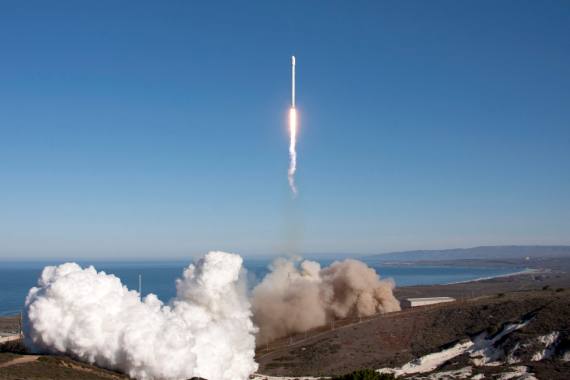
It is been a while for me, but today I had some pretty good SSTV reception from ISS on 145.800, the SSTV mode was martin1. For decoding SSTV data I use MMSSTV.
04-09-2013:
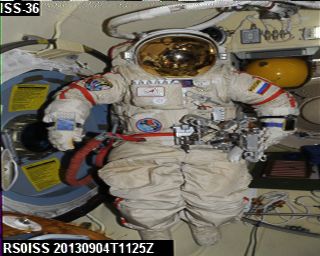

The transmissions started late in the pass and I think it has to do with the fact that our Italian astronaut is taking in consideration his radio friends in Italy. I was a little premature with this comment and IK1SLD gave the right information. He wrote to me via the AMSAT-BB mailing list the following.
Luca Parmitano doesn’t use the Kenwood TM-D710, this radio is used by Russian crew. The MAI-75 Experiment is a Russian experiment and the crew activates it when Moscow has AOS, so we lost 50% of the pass. Luca only use the Ericsson radio in the Columbus module.
Thank you Claudio (IK1SLD) for this update.
05-09-2013:

During the second day of the MAI-75 Experiment I could only receive and decode one image. It seems there where some problems with the radio because there was a carrier but no data being transmitted.
There is a new SDR# DDETracker plugin.
Ian Gilmour (MM6DOS) has created an add-on to the excellent SDR# program which allows DDE compatible software to control the receive frequency in SDR# Required for best results to correct for the Doppler shift when working with satellites with for example: WXTrack, SatPC32 and Orbitron.
![]()
The new version now also supports mode setting. I use this version in combination with SatPC32 and works great. Download the plugin via his website, copy two dll files and add the following to you SDRSharp.exe.Config file. (Newer SDR# version – Plugins.xml)
<add key="DDE Tracker" value="SDRSharp.DDETracker.DdeTrackingPlugin,SDRSharp.DDETracker" />
SDR# DDE Plugin: DDETracker (Version 5 beta: DDETracker V5 beta Binaries)
Update: 04-01-2014
The combination that is working for me, is SDR# Nightly build, the V5 beta binaries from Ian and SatPC32 V.12.8c. When talking to PA3GUO we found out that the current stable version (Rev 1000) isn’t working. When using SatPC32 the DDE interface is configured via the DivOptions.SQF file and I use the following settings:
- (1)
+ (2)
+ (3)
- (4)
- (5)
;
; Hints
;
; The +/- signs in lines 1,2,3,4 and 5 allow manual changes of program
; options whiche cannot be done in the menu 'Setup' and its sub menus.
;
; Don't forget to save possible changes, please!
; All changes require a program re-start to take effect.
;
; Line #1: Rotor and CAT steering functions
+: are available in a 2nd program instance,
; -: are not available in a 2nd instance (default),
; Line #2: The "general" DDE interface will output data
, +: constantly,
; -: only when the satellites elevation is > 0 (default),
; Line #3: Frequency values sent by the DDE interface
; +: do not include converter/transverter offsets (default),
; -: include converter/transverter offsets,
; Line #4: SatPC32 steers
; +: only the Downlink frequency and mode,
; -: Downlink and Uplink frequencies and modes (default)
;
; Line #5: Auxiliary files will be opened with
; -: Notepad (default).
; +: the build-in editor.